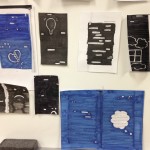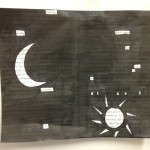Aug
2013
Blackout Poetry
Have you heard of Blackout Poetry? This is a really simple, effective, fun way to introduce poetry. EVERYone can do this. As I tell my students, you don’t have to create something from scratch – the something is already there. It’s up to you to liberate the poetry from page – find the secret message and reveal it.
Laura Randazzo, one of my favorite sellers on TpT, created a FREE Blackout Poetry product that my students have classroom tested and approved. We began by watching the free Prezi that she created. If you aren’t familiar with Prezi (nickname for Presentation), it’s basically like an online Powerpoint, but way more fun. You don’t need any special equipment – just Internet access. This Prezi walks you through the process of creating Blackout Poetry.
Teacher Tip: I warned them the day before our lesson to bring dark markers to class (and I rustled up as many as I could find in my teacher stash as well) as well as scissors (in case they wanted to trim their poem).
To prepare for this lesson, I chose several dozen of my favorite classroom novels. I hauled my pile to the copy room, opened each book up to a random page, and copied it. That way, we aren’t destroying any books. Since my students sit in groups in my classroom, I placed a pile of copied pages at each table group and asked them to pick a page that ‘spoke to them.’ Warning: advise your students NOT to read the page. This will put an unshakable idea into their head about what the page should be about. BIG mistake! It’s best to just skim the words, like scanning the food in your refrigerator, for a basic idea of what you want. There was a lot of discussion and paper-passing, but my students settled on their final decisions within a few minutes.
After we watched the Prezi, I asked my students to start with a pencil and look for a special word (anchor word) from which they could build a message. “But Mrs. D., what should the message be about?” Great question. I asked them to think about themes we have learned through our novels and short stories throughout the year. Think about universal messages about life, truths, or observations about humanity. That seemed to be a great place to start for the vast majority of my students. The more advanced poets didn’t need as much direction and just dug right in.
Once they had a potential poem sketched out in pencil, I directed them to try out their poem on a classmate. Ask for a reaction and feedback. Make any necessary revisions, then finally go for the marker and start blacking out what isn’t needed.
As an extension for some students, I invited them to insert a blackout image that complimented the poem. As you can see in the sample images below, the students rose to the challenge!
The beautiful results were then displayed for the remainder of the poetry unit 🙂
![]()



